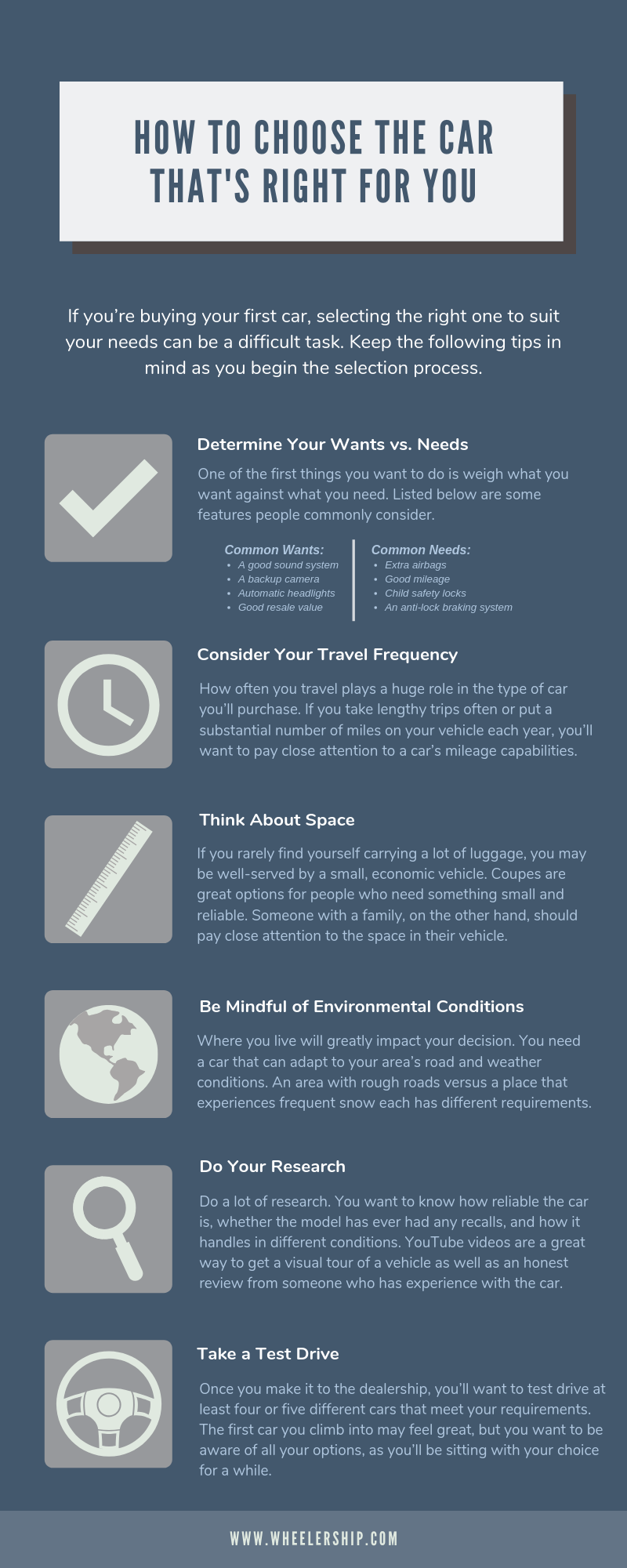
If you’re buying your first car, selecting the right one to suit your needs can be a difficult task. There are hundreds of models to choose from, and you want to be sure you’re putting your investment in the right place. It’s best not to walk right into a dealership without any idea of what you’re looking for. You should first familiarize yourself with some different options and decide what best aligns with your needs. In this article, we list out some things to consider before you make a final decision. Study our tips and keep them in mind as you begin the selection process.
Determine Your Wants vs. Needs
One of the first things you want to do is weigh what you want against what you need. Some cars look flashy and have all the bells and whistles, but you want to prioritize. Make two lists and decide if each item really belongs where you’ve put it. Listed below are some features people commonly consider.
Common Wants:
- A good sound system
- Comfortable seats
- A backup camera
- Automatic headlights
- Power doors
- Good resale value
- Start/stop buttons
Common Needs:
- Extra airbags
- Child safety locks
- Good mileage
- An anti-lock braking system
- A spare tire/tire repair kit
- Cruise control
When considering your needs and wants, decide whether or not you can move around the things on your lists. Power doors may not be a necessity for some people, but if you carry a lot of heavy groceries or car seats to and from your vehicle, this feature may rank higher on your list. If you’re a newer driver, a backup camera can ease a lot of anxiety. Some people are willing to sacrifice cruise control for a different feature that better suits their needs.
Ultimately, you have to decide how you’ll be using your car. Shopping for a vehicle isn’t a one-size-fits-all process, so knowing your general preferences up front allows you to delve deeper into other aspects of the decision-making process.
Consider Your Travel Frequency
How often you travel plays a huge role in the type of car you’ll purchase. Do you have a long commute to work? How often do you vacation? In 2015, road trips comprised 39% of vacations in the U.S. If you take lengthy trips often or put a substantial number of miles on your vehicle each year, you’ll want to pay close attention to a car’s mileage capabilities. In this case, you probably won’t want a sports car or a car with a V8 engine—instead, you may be better served by a more fuel-efficient vehicle such as a Honda Civic or a Subaru Forester. It’s also good to plan out a general fuel budget and pay attention to the type of fuel your car requires.
Think About Space
Do you usually travel by yourself? If you rarely find yourself carrying a lot of luggage, you may be well-served by a small, economic vehicle. Coupes are great options for people who need something small and reliable. Someone with a family, on the other hand, should pay close attention to the space in their vehicle. SUVs can be deceivingly small in size, and you don’t want to discover any inadequacies after you’ve already made your purchase.
When deciding on the size of your car, also consider your future plans. If you’re planning on keeping the car for five years and want to start a family within that time frame, you want to get something you won’t have to replace. If you aren’t ready for an SUV yet, a hatchback provides a good amount of extra space.
Be Mindful of Environmental Conditions
Where you live will greatly impact your decision. You need a car that can adapt to your area’s road and weather conditions. An area with rough roads versus a place that experiences frequent snow each has different requirements. Tires and rims, in particular, are important things to consider when it comes to road conditions. Chrome Nissan Altima rims may be great for city driving, whereas a Ford Ranger with steel rims and sturdy tires is great for rough terrain.
Do Your Research
Do research. Do a lot of research. You want to know how reliable the car is, whether the model has ever had any recalls, and how it handles in different conditions. Sift through user reviews and see what issues seem to come up the most. YouTube videos are a great way to get a visual tour of a vehicle as well as an honest review from someone who has experience with the car. User experience is always the best way to gauge what you’ll be working with, and these people aren’t paid to talk up a vehicle—they’re simply giving their honest opinion.
Another thing to look into is potential repair costs. The cost of things such as brakes, engines, and batteries will differ from vehicle to vehicle. Changing the brakes on a Honda Civic, for example, is far easier than changing the brakes on a Volkswagen Passat. Some cars require computer systems for the electronic components, while others do not. You don’t want to be surprised by high repair costs down the road, so this is something you’ll want to consider. If you’re a handy person who likes to do your own repairs, that’s an additional bonus to take into account.
Take a Test Drive
Once you make it to the dealership, you’ll want to test drive at least four or five different cars that meet your requirements. The first car you climb into may feel great, but you want to be aware of all your options, as you’ll be sitting with your choice for a while. Evaluate the height of the seats, how the brakes react—even how comfortable the seatbelts are. You can even drive a few cars outside of your budget just to know what it feels like.
Choosing a car is exciting, but it can be stressful as well. If you’re visiting several different dealerships, you’ll eventually feel worn down. Don’t compromise, however, unless you consider it to be completely necessary. People are usually willing to work with you on prices and payments. Knowing what you’re looking for will alleviate some of this stress by giving you a clear picture in your head. Take your time, relax, and enjoy your new car.



